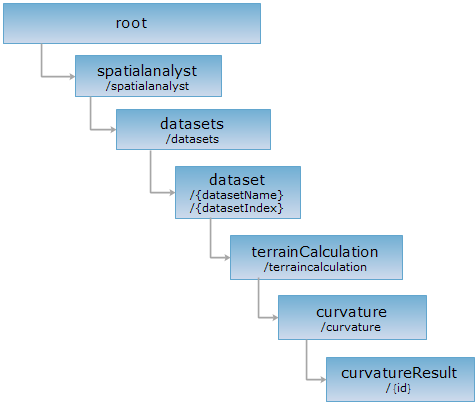URI
<curvature_uri>/{id}[.<format>]
Supported methods
Parent resource
Introduction
The resource of curvature, i.e., the result of a curvature.
Supported Methods:
- GET: Gets the result of a curvature.
- HEAD: Checks whether curvatureResult resource exists, or whether it can be accessed.
Supported output formats: rjson, json, html, xml.
Resource hierarchy

HTTP request methods
Implement the HTTP request on the following URI, where supermapiserver is the server name, with rjson being the output format.
http://supermapiserver:8090/iserver/services/spatialanalyst-sample/restjsr/spatialanalyst/datasets/JingjinHillshade@Jingjin/terraincalculation/curvature/{id}.rjson
GET request
Get a result of the curvature.
Response structure
The response results include three datasets, identified by fields:
| Field | Type | Description |
| averageCurvatureResult | DatasetSpatialAnalystResult | The average curvature dataset. |
| planCurvatureResult | DatasetSpatialAnalystResult | The profile curvature dataset. |
| profileCurvatureResult | DatasetSpatialAnalystResult | The plan curvature dataset. |
Response example
Performing a GET request on http://localhost:8090/iserver/services/spatialanalyst-sample/restjsr/spatialanalyst/datasets/JingjinTerrain@Jingjin/terraincalculation/curvature/6b7fe42a934c49fa93fe5b8b7541d2db_e9e94b4996c247798d7d0f985e6f0c1a.rjson can retrieve detailed information on the curvatureResult.
{
"averageCurvatureResult": {
"dataset": "test1@Interpolation",
"message": null,
"recordset": null,
"succeed": true
},
"planCurvatureResult": {
"dataset": "test3@Interpolation",
"message": null,
"recordset": null,
"succeed": true
},
"profileCurvatureResult": {
"dataset": "test2@Interpolation",
"message": null,
"recordset": null,
"succeed": true
}
}
HEAD request
Asks for the response identical to the one that would correspond to a GET request, but without the response body. This is useful for retrieving meta-information written in response headers, without having to transport the entire content. The meta-information includes the media-type, content-encoding, transfer-encoding, content-length, etc.
HEAD request can be used to check if the curvatureResult resource exists, or if the curvatureResult resource can be accessed by clients. It can also determine if the curvatureResult resource supports an output format <format> if performed on a URI with .<format> included.